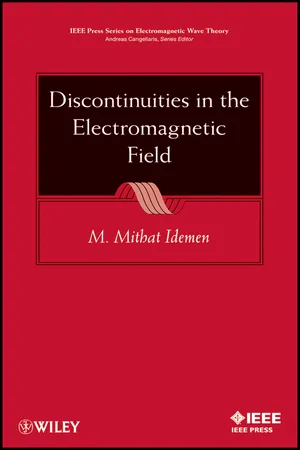![]()
Chapter 1
Introduction
A man may imagine things that are false, but he can only understand things that are true.
Isaac Newton
Almost all mathematical problems connected with the electromagnetic phenomena require solutions of the Maxwell differential equations
under certain supplementary restrictions stipulated on certain surfaces. In (1.1a–d) E, D, H, and B stand for the electric field, electric displacement, magnetic field, and magnetic induction, respectively, while ρ and J are the volume densities of the charges and currents. As to the parameter t that appears in (1.1a,b), it is, as usual, the time. The surfaces that bear the above-mentioned supplementary restrictions are either the interfaces between bodies of different constitutive parameters or surfaces that support surface charges and currents† or material sheets that model very thin layers. The supplementary restrictions in question are the relations that state the physically admissible discontinuities that may occur on these surfaces. They consist, in general, of the so-called boundary conditions that give the jump discontinuities on the surfaces in questions. If the discontinuity surfaces also involve sharp edges and/or sharp tips, then some components of the field become infinitely large at some points. In this case, in addition to the boundary conditions, one also has to know the physically admissible asymptotic behaviors of the field near those points because, as was shown more than 60 years ago by Bouwkamp [1], one can construct many solutions to the Maxwell equations under the given boundary conditions. Of course some of these solutions are not acceptable from physics point of view. Depending on the nature of the singular point, the relations that state the asymptotic behaviors in question are called the edge conditions or the tip conditions.
It is worthwhile to remark here that any relation written on a surface cannot be treated as a boundary condition for the electromagnetic field. In order to be so, it must also be compatible with the Maxwell equations. The spectrum of the electromagnetic waves used in the telecommunication is enlarging every day more and more toward very short waves. Hence many types of roughness, which had been assumed to be negligible in earlier investigations in order to reduce mathematical difficulties, became today unavoidable. In studies to be made in forthcoming days, one will have to consider the effects of these types of roughness on the propagation of waves. Therefore rigorous and detailed investigations of the boundary, edge, and tip conditions for various geometrical and physical structures are of crucial importance from both pure scientific and technological applications points of view. The aim of the present monograph is to study the discontinuities (i.e., singularities) in questions in their most general framework and discuss the validity of some particular relations that are in use in current literature. Our fundamental basis will be the so-called distributions (or generalized functions). In order to clarify the crucial role of this concept in the present study, it will be useful to reexamine the derivation of the classical boundary conditions in almost all textbooks.
On those days when the Electromagnetic Theory had been established, one had a huge heap of scientific knowledge in theoretical physics, especially in fluid mechanics. With this potential, the scientists of that time (i.e., mathematicians, physicists, and engineers) had formulated and solved many mathematical problems that could have interesting and important interpretations in terms of the electromagnetic notions. First problems were those that needed to find the explicit expressions of the fields created by various sources distributed in the vacuum. They were very easy. Soon later, one had considered the problems connected with bodies having simple geometrical shapes such as infinite planes, infinitely long cylinders, whole spheres, whole ellipsoids, and so on. They were also rather easy and tractable with known techniques provided that the boundary conditions to be satisfied on the surfaces of the bodies were known beforehand. It was at this stage that the struggles to reveal the discontinuities of the electromagnetic field were started. The methods that seemed most propitious were what are based on the applications of the Gauss–Ostrogradski and Stokes theorems (see Smirnow [2, pp. 177, 197]). Although these applications are repeated in almost all textbooks, we want to recapitulate them here in order to clarify the philosophy of the method adopted in the present study. To this end, consider, for example, (1.1c) and integrate it inside a volume ϑ bounded by planar boundaries of very small areas (see Fig. 1.1). Assume that D as well as its partial derivatives of the first orders are all continuous inside ϑ except on a regular surface ΔS. To avoid useless complexities, assume also that the field depends only on two space coordinates. Then a careless application (without regarding the validity conditions) of the Gauss–Ostrogradski theorem to
yields
Here Q stands for the total charge existing inside ϑ. If Q consists of the surface charge distributed with density ρS on S, then by making h → 0 in (1.2b) one gets
or
Here
and
show the values of the normal component of
D which are observed when one approaches
S from lower and upper sides, respectively.
Quite similarly, from (1.1a,b,d) one gets
The field JS appearing in (1.2g) is the density of the surface current that flows on S.
The relations in (1.2.d–g) are the classical boundary conditions that are satisfied on the interface between two regions filled with different materials. They are in use since the first days of the Theory to find solutions of the electromagnetic problems, which are in complete agreements with experiments. But the mathematical analysis made to reveal them is obviously not legitimate. Indeed, in order for the Gauss–Ostrogradski and Stokes theorems to be applicable, the fields E, D, H...












